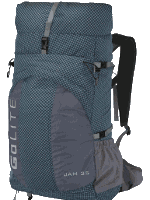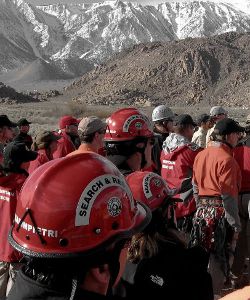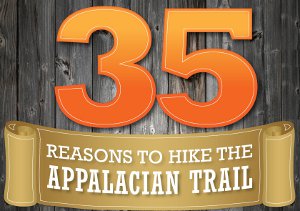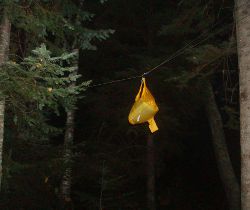
Hiking Dude Blog
2025 - Aug Jul
2024 2023 2022 2021 2020 2019 2018 2017 2016 2015 2014 2013 2012 2011
10/25/2012
GoLite Jam Packs
 Lightweight gear tends to be pretty expensive and that's why I've made some of my own gear.
Lightweight gear tends to be pretty expensive and that's why I've made some of my own gear.But, I keep looking around for less expensive replacements for what I have as my gear gets tattered and worn. GoLite has it's Jam Packs available now. The 50L weighs 30oz. and costs $132 - in case you're looking for a lightweight pack.
They've also got their down jackets and raingear on sale. It's still going to cost some $$$, but you might want to take a look at GoLite.com. I've purchased one of their down coats and an umbrella for my hikes this year and have gotten lots of use out of them.
Hike On
11/05/2012
Hiking Talk
 My first University of Scouting experience last weekend was great fun. I was asked to present a talk about Lightening the Load of Scout Treks since I've done a couple long-distance hikes now and am a total proponent of lightweight efforts.
My first University of Scouting experience last weekend was great fun. I was asked to present a talk about Lightening the Load of Scout Treks since I've done a couple long-distance hikes now and am a total proponent of lightweight efforts.I spent my morning attending the mandatory Unit Commissioner class (yawn) and then listened in on Backpacking 101 and a Preparing for Philmont presentations which were very interesting. I wanted to make sure my end-of-the-day talks did not contradict what those presenters said too badly. :-)
My big, old pack full of 'normal' gear was opposed to my new, lighter pack full of lighter gear. For the most part, people are interested in the gear of going lightweight, but that really is just the simple part. We also discussed:
- What Lightweight Is
- How Safety and Comfort are Affected
- Advantages of Going Light
- How Lightweight Promotes Scouting Aims
- Cost vs. Weight of Hiking
I've developed my own definition of Lightweight Backpacking:
Minimize the resources required for a successful outing by increasing resource efficiency and outdoors skills.
Resources include equipment, clothing, food, and water that you take into the wild. If you just buy the smallest, lightest, highest quality gear items you can waste a ton of money for a very small weight reduction. Taking a wider view of Lightweight means you are preparing and becoming well-skilled so you can make better use of what you take.
 Just a couple examples:
Just a couple examples:- Slowing your pace or hiking in cooler parts of the day so you don't sweat means you need to carry less water which is very heavy.
- Spending an extra $90 on hiking poles that save 10 ounces instead of on a titanium cook set that saves 4 ounces
- Using ritz crackers instead of tortillas cuts the weight of lunch in half for the same calories.
- If you lose 10 pounds while getting in shape, that's 10 pounds you don't need to carry over the mountains.
I've been asked by a few local troops to come and talk to their scouts about this topic. My next talk is tomorrow night and then one in December. Hopefully, I'm helping to make those wilderness treks more fun for young adventurers. If I can save just one youth from a life of overpacking, it's all worth it! :-)
Hike On
11/12/2012
Hiker Rescues
 Busy few days for lost hikers in the news. Too often, it's just silly lack of planning and skills that put rescuers in danger to help foolish folks. Many people may not realize that the majority of search and rescue team members are volunteers willing to sacrifice their free time to help others in need. Every time they go out looking for someone needing help, they go out into dangerous conditions and sometimes get injured themselves.
Busy few days for lost hikers in the news. Too often, it's just silly lack of planning and skills that put rescuers in danger to help foolish folks. Many people may not realize that the majority of search and rescue team members are volunteers willing to sacrifice their free time to help others in need. Every time they go out looking for someone needing help, they go out into dangerous conditions and sometimes get injured themselves.So, hey, BEFORE you go outside, make a plan and tell someone your plan. Check the weather forecast. Take more gear than just a t-shirt and jeans. And, for Pete's sake, take a flashlight!
On Sunday, a lone hiker without a flashlight, near Camden ME, called 911 because it got dark. 10 firefighters searched, found him, and escorted him back to trailhead. story
On Saturday, 25yr old camper walked away alone from friends at campsite in the early morning and became lost on Vancouver Island, BC. Called 911 and SAR folks came looking. Got a ride out with a truck driver. Friends didn't even realize he was missing. story
On Friday, 43yr old hiker without a flashlight started day hike of Horsetail Falls in OR. Wearing jeans, t-shirt, and jacket, it took longer than he expected and he ran out of daylight. Called 911 and searchers found him and escorted him to trailhead. He burned his hat and backpack to stay warm. ?!?! story
A 56yr old Appalachian Trail hiker got stranded when the Sandy storm dumped snow in the Great Smoky Mountains park. Called 911 and two park rangers hiked in. A nine-hour hike through snowdrifts only got them to a shelter four miles from the hiker. Then, a rescue helicoptor found the thru-hiker and airlifted him out. story
Hike On
Leave Comment
Posted: 11/12/2012
Posted: 11/12/2012
12/11/2012
Once In a Lifetime

 A thru-hike of the Appalachian Trail is refered to as a once in a lifetime trek. But, there are some folks that have done it many times, so that's a bit of a stretch. But, there are some things that really do occur once in a lifetime.
A thru-hike of the Appalachian Trail is refered to as a once in a lifetime trek. But, there are some folks that have done it many times, so that's a bit of a stretch. But, there are some things that really do occur once in a lifetime.Tomorrow at a little after noon, there will be six 12s on your digital watch - that won't happen again for 1,000 years. As a matter of fact, the next time a similar event happens is about 100 years away, on 01:01:01 01/01/2101
So what? Well, tons of people are having weddings tomorrow and other special events. Other than that, not much will happen. But, it's pretty cool to notice that you were alive and kicking on this special date.
Great opportunity to go on a 12-mile hike!
Hike On
Leave Comment
Posted: 12/11/2012
Posted: 12/11/2012
12/18/2012
Better Hike


Just checked the weather forecast. Looks like I'd better get a couple good hikes in today and tomorrow.
Hike On
.
Leave Comment
Posted: 12/18/2012
Posted: 12/18/2012
02/13/2013
Animal Tracks

 What do fresh snow, mud, and dirt have in common?
What do fresh snow, mud, and dirt have in common?They're perfect for finding animal tracks on your next hike!
But, once you've found the tracks, you need to figure out what animal made them. That can be a challenge, especially for people just starting their outdoors adventures.
These Animal Track ID Cards are great for identifying 16 animals you might find on your travels, from the tiny mouse to the huge bear. It's a great resource to print and keep in your pocket for quick reference.
What should you do if a young one asks you, 'Hey, what's that print?'
Hand him the sheet so he can figure it out himself instead of impressing him with your infinite wisdom and simply saying, 'Oh, that's a wolf.' Discovery is the best teacher!
Hike On
(If that link above doesn't work, see the backup.)
.
Leave Comment
Posted: 02/13/2013
Posted: 02/13/2013
02/18/2013
Swami's Hike
Swami, from Australia, hiked around the USA over the past 18 months - completing the AT, PCT, CDT, AZT, SHT, and some other trails. Just an amazing trip and person.
I met Swami heading southbound on the Arizona Trail while I was heading north. I didn't realize then what sort of wild hike he was on. See his website at TheHikingLife.com.
Here's an Australian news story about his adventure:
I met Swami heading southbound on the Arizona Trail while I was heading north. I didn't realize then what sort of wild hike he was on. See his website at TheHikingLife.com.
Here's an Australian news story about his adventure:
Leave Comment
Posted: 02/18/2013
Posted: 02/18/2013
02/19/2013
Why Hike the AT?

 Click the image to view a fun map image of the Appalachian Trail with 35 reasons to hike the trail.
Click the image to view a fun map image of the Appalachian Trail with 35 reasons to hike the trail.And, here's a few more oddities, tidbits, and fun about the Appalachian Trail:
- Over 250 shelters cover the trail with spots to spend the night - one about every 10 miles.
- A thru-hike costs $3,500 to $5,500 - depending on how much time is spent in towns.
- A bit over 700 people reported hiking the entire AT in 2011.
- Over 12,000 people have reported hiking the entire AT.
- Max Patch Bald is considered by many to have the best views of any spot on the trail.
- Trail Magic is common and a wonderful boost to hikers.
- Roan High Knob is the highest shelter on the trail at 6,285 feet.
- Clingman's Dome is the highest point on the trail at almost 6,700 feet.
- Bear Mountain Bridge is the low point of the trail at 124 feet.
- Around 160,000 white blazes mark the trail.
- Spy Rock is a Confederate army lookout.
- Pennsylvania is called Rocksylvania due to the roughness of the AT through that state.
- Most thru-hikers pick up trail names at some point. It's easier to remember Hiking Dude than Bob.
- 100 Mile Wilderness in Maine is the most remote section of the AT.
- The Appalachian Trail is 1/3 of the Triple Crown which includes the Pacific Crest Trail and Continental Divide Trail.
Can you think of any other reason to hike 2,200 miles?
Hike On
If that image can't be found see alternate image.
02/26/2013
Food Hanging
 It's not so bad when just car camping, but if your food is lost while deep in the backcountry, you can be in a world of hurt. With a couple days hiking between you and the nearest trailhead, running out of food probably won't kill you, but it's a big step in that direction.
It's not so bad when just car camping, but if your food is lost while deep in the backcountry, you can be in a world of hurt. With a couple days hiking between you and the nearest trailhead, running out of food probably won't kill you, but it's a big step in that direction.What? How can someone LOSE their food? - you might ask.
- Water - Rain and crackers don't mix well. Dropping a food bag into a lake or stream can ruin unprotected items. Fortunately, this is easy and light to prevent. Repackage everything into zip-loc bags. This reduces packaging weight and keeps everything safe from moisture. Putting multiple small bags into a larger 2.5 gallon zip-loc increases the protection.
- Dirt - When you drop your tortilla with peanut butter on it, you already know which side will hit the ground! You can blow dirt off many items, but not all. Being careful when opening packages, passing bowls, and stirring pots is the best guard against dropping and spilling food. No one's going to want that ramen after you tip the cookpot over, are they?
There's not much concern about dirt getting into food in transit, but spilling food is a common problem. - Stupidity - The food is forgotten in the car, along the trail, or at the previous campsite. By just not paying attention and double-checking yourself, you can forget your food. Yes, I have seen it happen!
- Animals - Critters are opportunists. Anything that smells interesting gets investigated. And, they can find the smallest bits hidden far out of sight. The most common stealers are mice, chipmunks, raccoons, other rodents and birds. Bears generally stay away from people, unless they've been habituated - learned to associate people with easy food. In those popular locations with habituated bears, special regulations are in place for visitors which often includes use of bear-proof cannisters.
Whether it's bears or mini-bears (rodents) that are the concern, protecting food is handled in a similar manner. Storing it in a smell-resistant bag and hanging it out of reach keeps it safe.
On the Arizona Trail, there were often no trees to hang my food. But, bears weren't a concern either. There are wire mesh food bags available that mini-bears can't chew through, like OutSak.
For those times when you need to hang, I've found the PCT Method to be the best if there are large trees around. Along the Superior Hiking Trail, I could often only find smaller trees and came up with my own way of hanging so the food is high enough and away from the tree.
- Throw rope with carabiner on end over high branch.
- Clip food bag to carabiner. Lift carabiner and food bag as high up the rope as possible and loop rope through carabiner so it doesn't slide.Walk the other end of the rope away from the tree to move the bag out from the tree.
- Tie rope to another tree as high up as I can reach.
This puts the food bag well over 10 feet up since I can reach up 8 feet. Well, at least I didn't lose any food!
But, here's something new and interesting...
A couple guys at University of Wisconsin in Stout, WI have designed a new product for hanging food bags. It's supposed to be simple to use and secure from pesky food stealers.
They made this video demonstrating how to use it. Unforatunately, there aren't any close-ups of the device or explanation on how it works.
So, take a look and let us all know what you think - innovation or not?
Hike On
06/25/2013
My Little Friend
 One of the Leave No Trace principles to minimize impact is Travel and Camp on Durable Surfaces. One of the ways to interpret this is to stay on trails when hiking.
One of the Leave No Trace principles to minimize impact is Travel and Camp on Durable Surfaces. One of the ways to interpret this is to stay on trails when hiking.As you can see, that is a good idea not only to minimize impact but also to keep safe. I found his little friend of mine along the trail this morning while doing my daily hike. With the three cute little leafs, all shiny and green, he looks harmless enough. No prickly needles or scratchy thorns, but he can cause plenty of trouble if you touch him.
It's the urushiol in the poison ivy that causes skin irritation, more on some people than on others. By staying on the trail, keeping your eyes open, and paying attention to your surroundings, avoiding poison ivy isn't too difficult. When you go off trail, chances of running into it go way up. Actually, just off the trail is one of the best places for poison ivy to grow since it likes wood edges just like the side of a trail, road, or meadow.
It takes only a few minutes after contact with poison ivy for the urushiol to absorb into the skin, but it may take many hours for the itching, rash, and blisters to develop. Immediately washing off the contact area with soap and water is your best bet. Clothes that have contacted poison ivy should also be washed.
Poison Oak and Poison Sumac are also urushiol-producers and cause similar problems as poison ivy.
Burning poison ivy is especially dangerous because inhaling the smoke can effect your lungs.
Hike On Safely
Older Posts Newer Posts
Find more Hiking Resources at www.HikingDude.com


Follow Me
Recent Comments